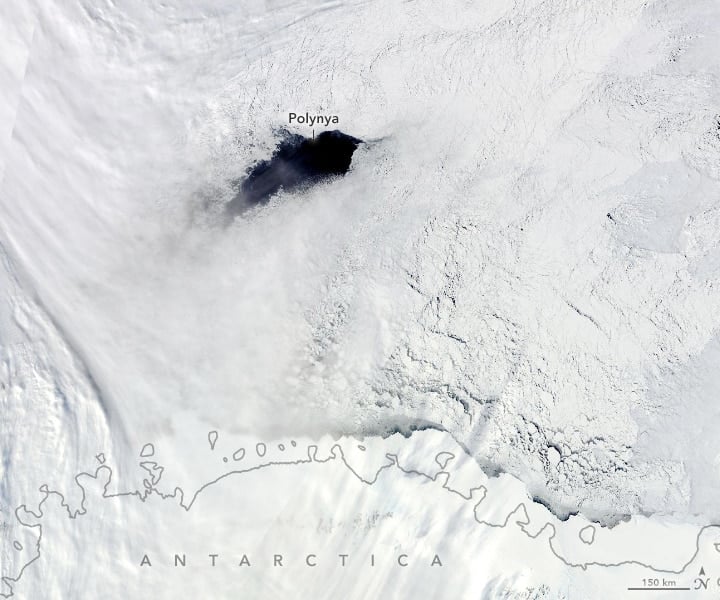Polynya is an oceanography term borrowed from the Russian (полынья) to refer to an open body of water surrounded by ice. Polynyas are mostly found in the Arctic and the Southern Ocean near Antarctica.
Types of Polynyas
There are two types of polynyas: coastal polynyas and open-ocean polynyas.
Coastal Polynyas
Coastal polynyas occur near coastlines and are usually formed by wind that blows sea ice away from the shore, creating an area of open water. This process of forming a polynya is known as ice advection.
Coastal polynyas can also form through the warm upwelling of seawater. This satellite image taken off the coast of Antarctica, near Ross Island and McMurdo Station on November 16, 2011 shows a coastal polynya.
The polynya was most likely formed by katabatic winds which blow from Antartica’s high interior and can reach speeds up to 200 miles (320 kilometers) per hour.
Open-Ocean Polynas
Open-ocean polynyas form when cracks form in the ice sheet far offshore, exposing the seawater.
An example of a open-ocean polynya is Maud Rise polynya, located in the eastern Weddell Sea. This polynya is named after the submerged mountain-like feature over which the opening in the sea ice forms.
The Maud Rise polynya can vary greatly in size, occurring routinely in early spring and sometimes over the winter. During the fall of 2017, the Maud Rise polynya grew from 9,500 square kilometers in mid-September to 80,000 square kilometers by late October.
NASA’s Terra satellite captured the Maud Rise Polynya on September 25, 2017:
Polynas in Antarctica are important in that they create light and nutrients conditions that enable seasonal, very dense blooms of phytoplankton to flourish. Phytoplankton are significant sources of carbon sinks.
References
Cheshire, L. (2020, July 23). Phytoplankton and polynyas. Earthdata. https://earthdata.nasa.gov/learn/sensing-our-planet/phytoplankton-and-polynyas
Deciphering the Maud Rise Polynya. (2019, May 22). Retrieved from https://earthobservatory.nasa.gov/images/145069/deciphering-the-maud-rise-polynya
Polynya off the Antarctic Coast. (2011, November 22). Retrieved from https://earthobservatory.nasa.gov/images/76474/polynya-off-the-antarctic-coast
This article was originally written on January 23, 2020 and has since been updated.
You Might Also Like
Fonte : National Geographic

















